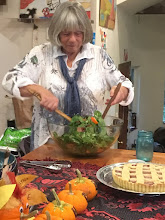 |
| Janet's fruit malt loaf |
While I was doing postgraduate studies at Newnham College, Cambridge University, as a Marshall Scholar, between 1966 and 1968, I lived in a house on Grantchester Meadows with four other graduate students at Newnham: Janet, An English woman doing graduate work in religious studies; Yoko, a Japanese student of anthropology; Polly, an American studying English literature; and Sue, an Australian, who was aloof (or shy) and whom I knew least. Our house was the last in a row of semi-detached houses on Grantchester Meadows, where the street ended and the path began. To take that path was to wind a pleasant, oh so English, way through the woods and the meadows to a little tea house, where one could take high tea. On the other side of the woods flowed the River Cam. Following an old Cambridge tradition, students punted down the river to Grantchester for breakfast at dawn after the all-night affairs of the post-exams May Balls, as I did with friends at Queens College after the bagpiper, following tradition, had welcomed the day from the ramparts of the college entrance and the ball had faded to an end.
Grantchester Meadows was made famous in the Pink Floyd song of that name and, earlier, by Rupert Brooke's "The Old Vicarage, Grantchester," which ends with the famous lines, "Still stands the clock at ten to three,/And is there honey still for tea?"
Because we in the Granchester Meadows house were students on limited budgets, we usually ate dinner "in hall" (the English equivalent of the student cafeteria in American universities), but every once in a while one of us would fill our house with the good smells of a kitchen at work, most often Janet, the oldest and the official liaison between our house and Newnham College. One day she made a fruit malt loaf, heavily flavored and different from any other sweet bread I had ever eaten, so I asked her for the recipe. For years I couldn't follow the recipe because its magic ingredient is that oh so English substance Ovaltine. Some stores in the States might have carried such a product, but not in the places where I lived since those golden days of Cambridge.
Now however, I can find Ovaltine even in stores in southern Oregon, so I have been able to make Janet's fruit malt loaf, from the recipe in my little cedar recipe box, written in my hand, on a plain white, unlined 3x5 card. On the back is the name of another friend from Cambridge, Heather Bayes. I used to play tennis with Heather, barefooted, on grass courts. Now that I have discovered her name on the back of my recipe, I wonder if I have gotten it wrong all these years. Was it Heather who gave me this recipe, not Janet? I don't think so because my memory has always had Janet as the baker, but why would Heather's name be on the back of the card?
Heather's or Janet's, it's a very English sweet bread and very good. I hope you'll try it.
Now however, I can find Ovaltine even in stores in southern Oregon, so I have been able to make Janet's fruit malt loaf, from the recipe in my little cedar recipe box, written in my hand, on a plain white, unlined 3x5 card. On the back is the name of another friend from Cambridge, Heather Bayes. I used to play tennis with Heather, barefooted, on grass courts. Now that I have discovered her name on the back of my recipe, I wonder if I have gotten it wrong all these years. Was it Heather who gave me this recipe, not Janet? I don't think so because my memory has always had Janet as the baker, but why would Heather's name be on the back of the card?
Heather's or Janet's, it's a very English sweet bread and very good. I hope you'll try it.
Next week: A Box of Stories (4) "Calling Benny"
FRUIT MALT LOAF
yield: one loaf
Ingredients
2 tablespoons Ovaltine
1/2 pound self-rising flour (=3 1/3 cups)
1/2 pound dried fruit
1 teaspoon baking powder
2 tablespoons Golden Syrup (another English product. Use honey.)
1 cup milk (coffee cup)
Preparation
Grease a loaf tin (loaf pan, in American English). Preheat the oven to mark #4 (350º).
To make
Combine and beat the first four ingredients. Heat the syrup and milk separately, then combine both with the flour mixtures. Turn the batter into the prepared loaf tin. Bake at mark #4 (350º) for 1 hour.



No comments:
Post a Comment